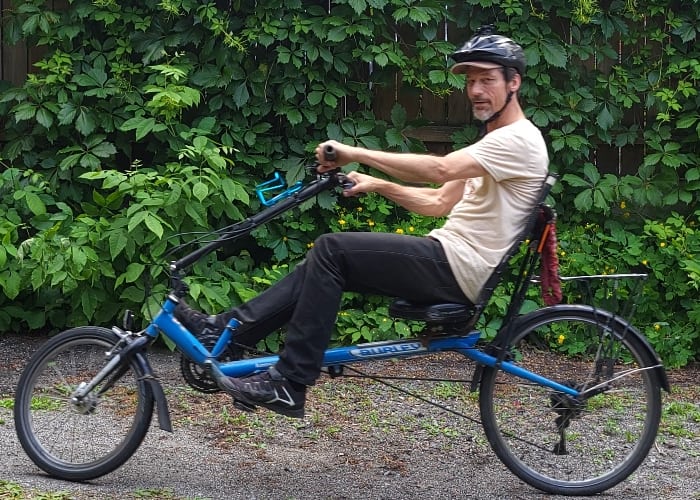There are people who love biking. There are cyclists so passionate they are out in all kinds of weather. And then there’s Richard Guy-Briggs.
Known around Ottawa as ‘the bike guy’, Guy-Briggs is an active transportation activist (and member of the Human Powered Vehicle Operators of Ottawa) who cuts an unusual figure as he weaves his way around town.
Some days, you can spot him tooling around the ByWard Market on his recumbent bike. On others, he might be pedalling furiously on a double-decker contraption, entertaining neighbourhood kids on his unicycle or pulling his canoe on a custom-made set of wheels.
Born in Ottawa but a seasoned traveller who has cycled across Canada and biked in far-flung locations like India, Australia, New Zealand, China, Fiji and the Cook Islands, Nepal and even the Netherlands, Guy-Briggs is, not surprisingly, a major advocate for bike safety and active transportation.
CAA Magazine dropped by his garage in downtown Ottawa, tinkering with his huge bike collection (including a rickshaw). We asked him about cycling and bike safety.
Why are you passionate about cycling?
A lot of people assume that the reason that I cycle is because of environmental reasons or health reasons. I find cycling is much more social than driving a metal cage through a public space.
Why do you enjoy riding a tall bike?
Tall bikes are fun because you can see right over the roofs of all the SUVs. You can look the truckers right in the eye. It’s a conversation starter that makes people smile.
What made you switch to a recumbent bike?
I used a hybrid bike to ride across Canada and Australia. I had problems with my lower back, neck, and wrists. So that is when I started looking at recumbent bikes. I asked the manufacturer to design and build a convertible tandem trike with extra leaf in the middle. I’ve cycled 800 kilometres, with a canoe on top, over various trips.
What problems do recumbent bike cyclists face?
Recumbent cyclists are the most vulnerable due to visibility issues, like stop lines, when other drivers make turns. The biggest problem I’ve had is in parking lots where people don’t back into their parking spaces, so they can’t see when they’re backing up.
What are the cycling challenges in Ottawa?
The bike lanes in Ottawa have gradually gotten narrower. Another issue is the double bike lanes, like on O’Connor Street. It’s not single bidirectional lanes. Plus, there are a lot of what I’ve called obstacle courses, like the first block of Beechwood Avenue. It’s a silly piece of infrastructure.
How does Ottawa's biking infrastructure compare to other cities that you visited?
The infrastructure in the Netherlands is really good. It’s wide enough in Amsterdam to overtake other cyclists if you meet slower ones. Montreal has pivoted and has wider single-direct lanes, which are great. Even on a wide trike, I can overtake other slower cyclists on those lanes. They work well, so I’m happy about that.
Any top tips for sharing the road?
If there’s infrastructure that’s marked as shared, pedestrians could stick to one side of the path. Motorists should be careful of vulnerable road users and understand that the infrastructure isn’t designed for all cyclists. There are cyclists who are outside of that design criteria because they’re faster, larger, heavier or they’re going to a place that isn’t serviced by a bike lane. So, the road still needs to be shared.
CAA cycling safety tips
When cycling, it is important to be safe when sharing the road. CAA has a useful guide for cyclists and motorists.
If you do find yourself in need of assistance while on two wheels, CAA Members get Bike Assist™ – our roadside assistance for bikes.


